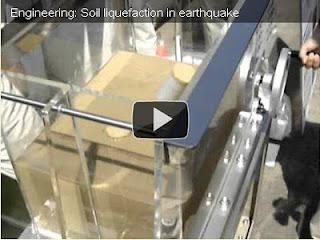
Ingeniería: ¿Qué es la licuefacción de los suelos?
Japanese education (higher education) is worldwide famous because of the emphasis given and resources spent in physical models. Today, after watching a program on the March 11th quake on NatGEO, and the effects of liquefaction on reclaimed land, I remembered I had recorded an interesting video back in 2006 at the Tohoku EE Fair. The experimentrecreates the impacts of liquefaction on civil structures, particularly on manholes, which explains what was observed during the great event of March. I invite you to enjoy it and learn.
For those who are not familiar with this term, let me remind you that liquefaction is a process by which the soil
suddenly looses its shear resistance due to the generation of high pore pressure (Wang and Sassa, 2007). The phenomenon occurs in saturated soils, but also in large masses of dry and loose soil loaded so rapidly that the escape from the voids is restricted (Bayan, 2008). As you may have realized, the term can be used to describe a wide range of phenomena. From the earthquake engineering perspective, liquefaction causes severe damage to civil structures; as I said, an example on the damages is represented by the impacts on manholes on the experiment shown on the video accompanying this entry. From a hydrological (geotechnical) perspective, static liquefaction is particularly interesting, because such phenomena could also be triggered under non-earthquake induced conditions. One example of the latter is the phenomena caused by continuous long duration rainfall that can saturate the boundary layer that develop over a rock layer (as observed in, e.g., Bayan, 2008), i.e., flowslides, which may have been the cause that triggered the largest mass flow event observed in the modern times of my country (Bolivia), in February 2011. Assuming that certain regions have low risk for earthquake events, the latter (flowslides) is a mayor concern in developing countries where rainfall induced landslide is a seasonal phenomenon; and it constitutes a concern because of the lack of historical data. No data for a phenomena that is expected to occur every year? Certainly, that could not be attributed to the lack of knowledge on the topic (there are several references, e.g., Poulos et al., 1984); it is simply due to the inexperienced management capacity.
How to monitor flowslides, and potential countermeasures Monitoring the geotechnical conditions is key to draw potential countermeasures. The question is what to investigate. Research suggests:1. Basically, managers should identify areas where historical events have occurred; carry SPT tests, acquire high temporal resolution rainfall records, and installation of piezometer network are suggested to be essential for the geotechnical investigation; on the other hand, the conventional safety factor appears to be not applicable for flow slides (Bayan, 2008).2. Dewatering (although expensive and not applicable in alluvial deposits); removal and replacement of the liquefaction-prone soil, when the layer is until 3.5m thick; for thicker layers: dynamic compactation, vibroflotation, stone columns and grounting may be more feasible (GEB, 2007);
3. Strengthen current structures (e.g., increase the number of pile foundations, increase the strength of walls) (Yasuda and Ogasawara, 2004).
References.
- Liquefaction evaluation procedure, Poulos Steve J.; Castro Gonzalo and France John W. 1984, Journal of Geotechnical Engineering, ASCE; Vol.111, No6, June pp. 772-792.
- Liquefaction potential of cohesionless soils, Geotechnical Engineering Bureau (GEB), NY, April 2007.
- On the pore pressure generation and movement of rainfall-induced landslides in laboratory flume tests, Wang, G., Sassa, K., 2007, Progress in Landslide Science.
- Soil liquefaction website, University of Washington (last update: Jan, 2000).
- Static Liquefaction for Flow Type Landslide at Karshingsa – A Case Study, Bayan, G., 2008.
- Studies on several countermeasures against liquefaction-induced flow and an application of a countermeasure to existing bridges in Tokyo, Yasuda, S., and Ogazawara, M., 2004.

